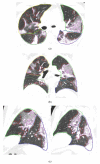Automated AI-Driven CT Quantification of Lung Disease Predicts Adverse Outcomes in Patients Hospitalized for COVID-19 Pneumonia
- PMID: 34069115
- PMCID: PMC8156322
- DOI: 10.3390/diagnostics11050878
Automated AI-Driven CT Quantification of Lung Disease Predicts Adverse Outcomes in Patients Hospitalized for COVID-19 Pneumonia
Abstract
The purpose of our work was to assess the independent and incremental value of AI-derived quantitative determination of lung lesions extent on initial CT scan for the prediction of clinical deterioration or death in patients hospitalized with COVID-19 pneumonia. 323 consecutive patients (mean age 65 ± 15 years, 192 men), with laboratory-confirmed COVID-19 and an abnormal chest CT scan, were admitted to the hospital between March and December 2020. The extent of consolidation and all lung opacities were quantified on an initial CT scan using a 3D automatic AI-based software. The outcome was known for all these patients. 85 (26.3%) patients died or experienced clinical deterioration, defined as intensive care unit admission. In multivariate regression based on clinical, biological and CT parameters, the extent of all opacities, and extent of consolidation were independent predictors of adverse outcomes, as were diabetes, heart disease, C-reactive protein, and neutrophils/lymphocytes ratio. The association of CT-derived measures with clinical and biological parameters significantly improved the risk prediction (p = 0.049). Automated quantification of lung disease at CT in COVID-19 pneumonia is useful to predict clinical deterioration or in-hospital death. Its combination with clinical and biological data improves risk prediction.
Keywords: COVID-19; artificial intelligence; multivariate analysis; outcome prediction; pneumonia; quantitative CT.
Conflict of interest statement
Philippe A Grenier has received speaker honorarium from Siemens Healthineers.
Figures

References
-
- Richardson S., Hirsch J.S., Narasimhan M., Crawford J.M., McGinn T., Davidson K.W., the Northwell COVID-19 Research Consortium. Barnaby D.P., Becker L.B., Chelico J.D., et al. Presenting Characteristics, Comorbidities, and Outcomes Among 5700 Patients Hospitalized with COVID-19 in the New York City Area. JAMA. 2020;323:2052–2059. doi: 10.1001/jama.2020.6775. - DOI - PMC - PubMed
-
- Docherty A.B., Harrison E.M., Green C.A., Hardwick H.E., Pius R., Norman L., Holden K.A., Read J.M., Dondelinger F., Carson G., et al. Features of 20 133 UK patients in hospital with covid-19 using the ISARIC WHO Clinical Characterisation Protocol: Prospective observational cohort study. BMJ. 2020;369:m1985. doi: 10.1136/bmj.m1985. - DOI - PMC - PubMed
-
- Wu C., Chen X., Cai Y., Xia J., Zhou X., Xu S., Huang H., Zhang L., Zhou X., Du C., et al. Risk Factors Associated With Acute Respiratory Distress Syndrome and Death in Patients With Coronavirus Disease 2019 Pneumonia in Wuhan, China. JAMA Intern. Med. 2020;180:934–943. doi: 10.1001/jamainternmed.2020.0994. - DOI - PMC - PubMed
-
- Phua J., Weng L., Ling L., Egi M., Lim C.M., Divatia J.V., Shrestha B.R., Arabi Y.M., Ng J., Gomersall C.D., et al. Intensive care management of coronavirus disease 2019 (COVID-19): Challenges and recommendations. Lancet Respir Med. 2020;8:506–517. doi: 10.1016/S2213-2600(20)30161-2. - DOI - PMC - PubMed
LinkOut - more resources
Full Text Sources
Research Materials

